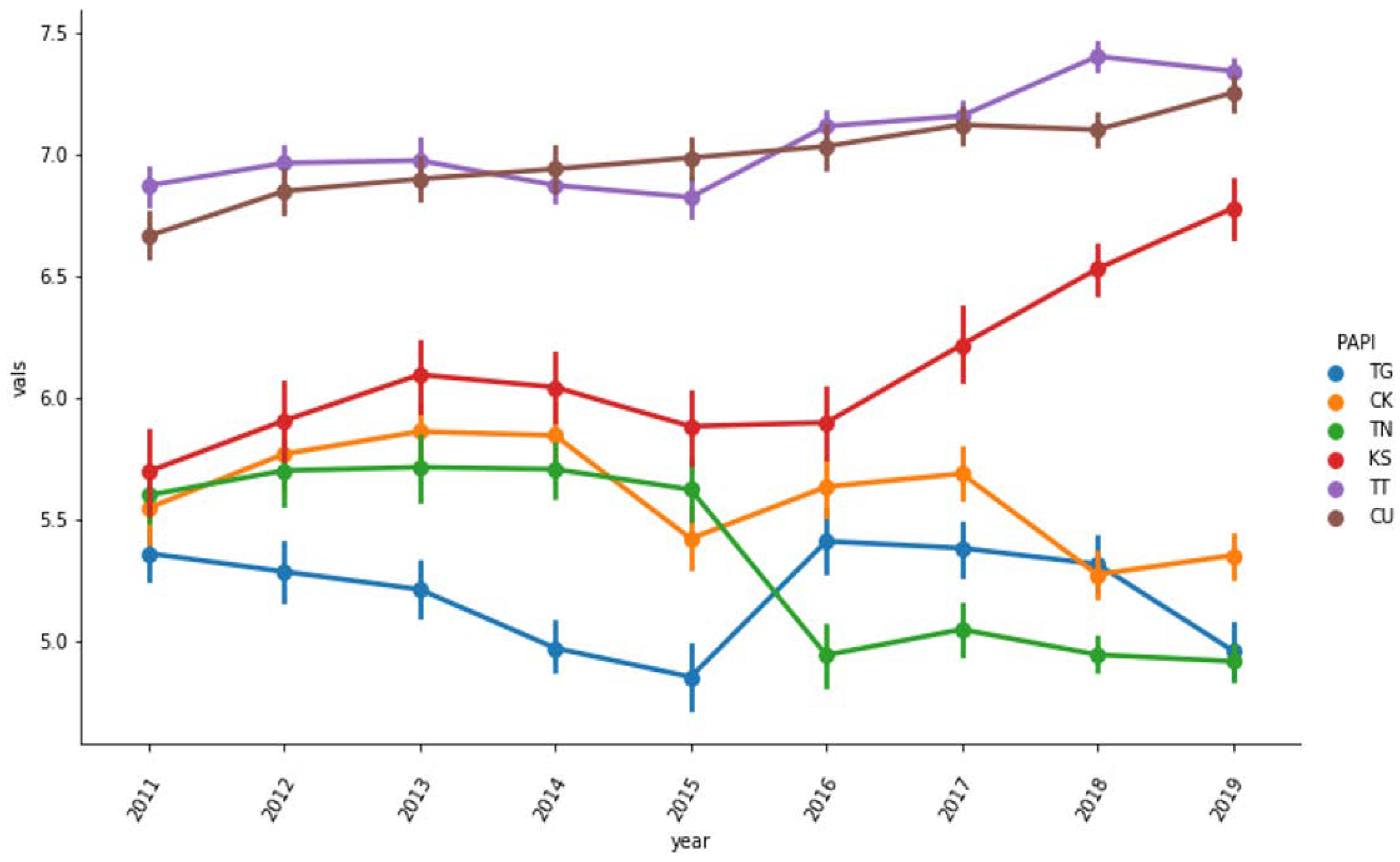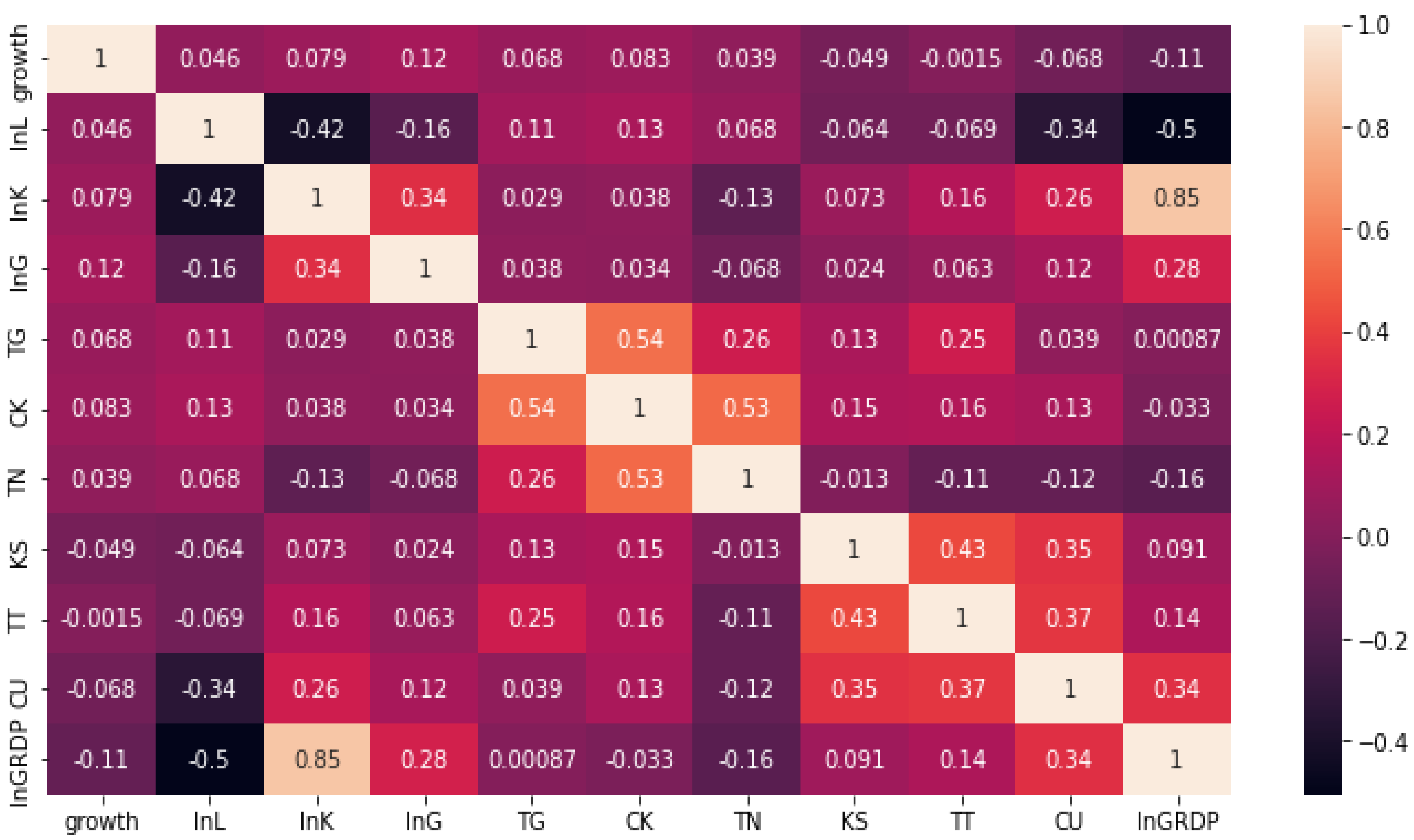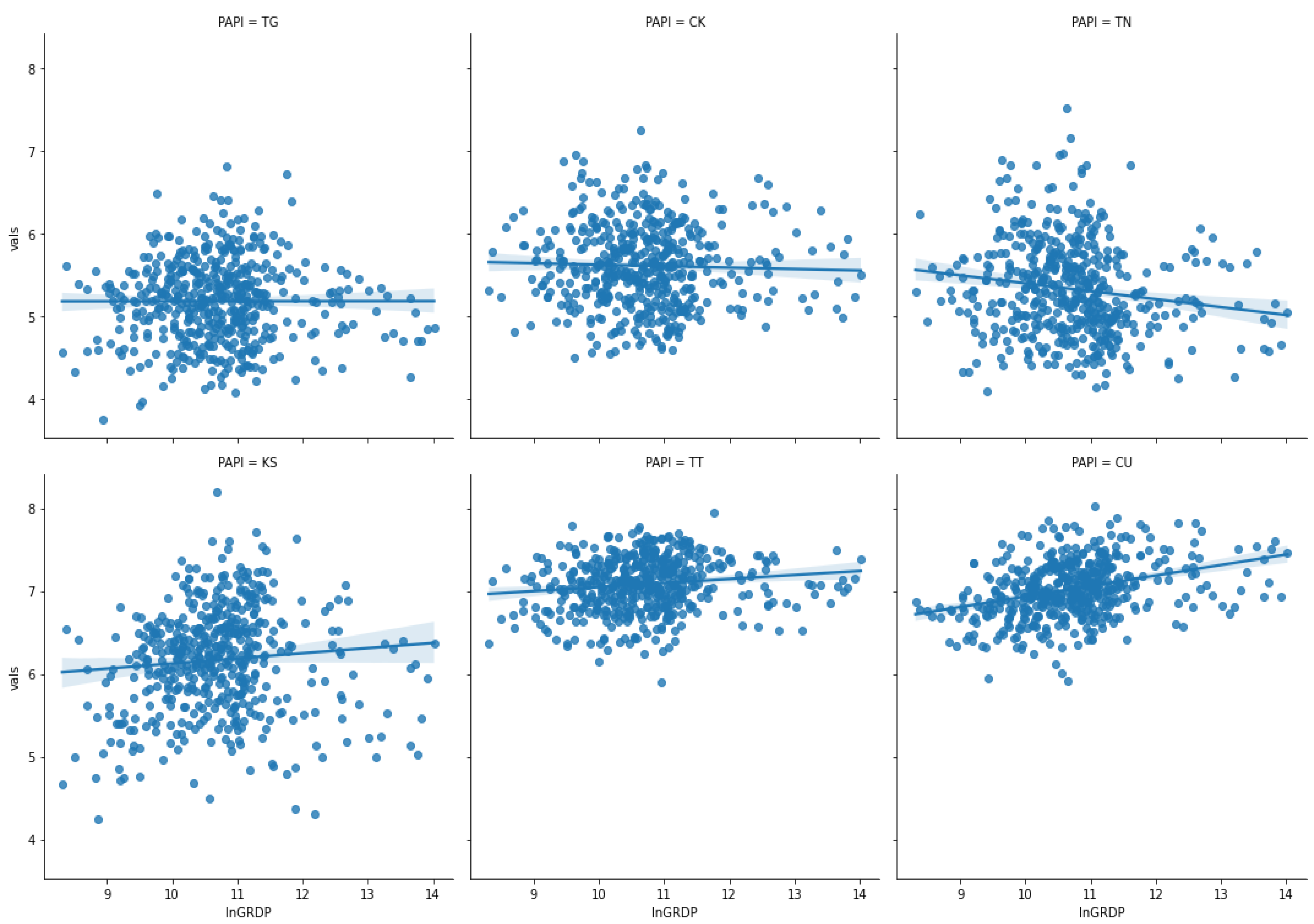The Impact of Quality of Public Administration on Local Economic Growth in Vietnam
Abstract
:1. Introduction
2. Literature Review
2.1. Definition of Concepts
2.2. Theories Related to the Impact of Public Governance Quality on Economic Growth
2.3. Evidence on the Impact of Quality of Public Administration on Economic Growth
3. Methodology
3.1. Research Model
3.2. Estimation Method and Data
4. Empirical Result
4.1. Descriptive Statistics
4.2. Correlation Matrix
4.3. Estimation Result and Discussion
5. Conclusions and Policy Implication
5.1. Conclusions
5.2. Policy Implication
5.3. Limitation and Suggestions
Author Contributions
Funding
Institutional Review Board Statement
Informed Consent Statement
Data Availability Statement
Conflicts of Interest
References
- Acemoglu, Daron, Simon Johnson, and James A. Robinson. 2004. Institutions as the Fundamental Cause of Long-Run Growth. Cambridge: National Bureau of Economic Research. [Google Scholar] [CrossRef]
- Alexiou, Constantinos. 2009. Government Spending and Economic Growth: Econometric Evidence from the South Eastern Europe (SEE). Journal of Economic and Social Research 11: 1–16. [Google Scholar]
- Arellano, Manuel, and Stephen Bond. 1991. Some Tests of Specification for Panel Data: Monte Carlo Evidence and an Application to Employment Equations. The Review of Economic Studies 58: 277–97. [Google Scholar] [CrossRef] [Green Version]
- Barro, Robert Joseph. 1990. Government spending in a simple model of endogenous growth. Journal of Political Economy 98: S103–25. [Google Scholar] [CrossRef] [Green Version]
- Barro, Robert Joseph. 1991. Economic growth in a cross section of countries. Quarterly Journal of Economics 106: 407–43. [Google Scholar] [CrossRef] [Green Version]
- Barro, Robert Joseph, and Xavier Sala-i-Martin. 2004. Economic Growth, 2nd ed. Cambridge: MIT. [Google Scholar]
- Buchanan, James McGill. 1987. The Constitution of Economic Policy. The American Economic Review 77: 243–50. Available online: http://www.jstor.org/stable/1804093 (accessed on 17 January 2022). [CrossRef] [PubMed]
- Cooray, Arusha. 2009. Government Expenditure, Governance and Economic Growth. Comparative Economic Studies 51: 401–18. [Google Scholar] [CrossRef]
- Dethier, Jean-Jacques. 1999. Governance and Economic Performance: A Survey. ZEF–Discussion Papers On Development Policy No. 5. Available online: http://ageconsearch.umn.edu/record/279846/files/ZEFdiscussionpaperno5.pdf (accessed on 17 January 2022).
- Faruq, Hasan Al. 2011. How institutions affect export quality. Economic Systems 35: 586–606. [Google Scholar] [CrossRef]
- Feriyanto, Nur, Dityawarman Aiyubbi El, and Achmad Nurdany. 2020. The Impact of Unemployment, minumum wage, and real gross regional domestic product on poverty reduction in provinces of Indonesia. Asian Economic and Financial Review 10: 1088–99. [Google Scholar] [CrossRef]
- Fukuyama, Francis. 1995. Trust: The Social Virtues and the Creation of Prosperity. New York: The Free Press. [Google Scholar]
- Glaeser, Edward Ludwig, and Raven Saks. 2004. Corruption in America. National Bureau of Economic Research Working Paper Series, No. 10821. Available online: https://doi.org/10.3386/w10821 (accessed on 17 January 2022). [CrossRef]
- Grindle, Merilee Serrill. 2004. Good Enough Governance: Poverty Reduction and Reform in Developing Countries. Governance 17: 525–48. [Google Scholar] [CrossRef]
- Kaufmann, Daniel, and Aart Kraay. 2004. Governance Indicators, Aid Allocation, and the Millennium Challenge Account (Development and Comp Systems). Munich: University Library of Munich. [Google Scholar]
- Kleinbaum, David George, Lawrence Louis Kupper, and Keith Muller. 1988. Applied regression analysis and other multivariable methods. Boston: PWS-Kent. [Google Scholar]
- Konstantakopoulou, Ioanna. 2022. Does health quality affect tourism? Evidence from system GMM estimates. Economic Analysis and Policy 73: 425–40. [Google Scholar] [CrossRef]
- Larcinese, Valentino, James Snyder, and Cecilia Testa. 2010. The Political Economy of Public Spending: Evidence from the US States. Milan: FrancoAngeli. [Google Scholar]
- Le, Hoang Anh, Hoang Nguyen Khai, and Pham Thi Ha An. 2020. The governance quality-growth nexus revisited: A new evidence from the Bayesian multilevel generalized linear model. Accounting 6: 413–20. [Google Scholar] [CrossRef]
- Lok, Peter, and John Crawford. 1999. The Relationship between Commitment and Organizational Culture, Subculture, Leadership Style and Job Satisfaction in Organizational Change and Development. Leadership & Organization Development Journal 20: 365–77. [Google Scholar]
- Mishkin, Frederic Stanley. 2001. The Transmission Mechanism and the Role of Asset Prices in Monetary Policy. NBER Working Papers 8617. Cambridge: National Bureau of Economic Research, Inc. [Google Scholar]
- Ndulu, Benno, and Stephen O’Connell. 1999. Governance and Growth in Sub-Saharan Africa. The Journal of Economic Perspectives 13: 41–66. Available online: http://www.jstor.org/stable/2646984 (accessed on 17 January 2022). [CrossRef] [Green Version]
- Siddiqui, Danish Ahmed, and Qazi Masood Ahmed. 2013. The effect of institutions on economic growth: A global analysis based on GMM dynamic panel estimation. Structural Change and Economic Dynamics 24: 18–33. [Google Scholar] [CrossRef] [Green Version]
- Smith, Adam. 1755. Peace, Easy taxes, and a Tolerable Administration of Justice. In The A B C of Finance. Stockport: Dodo Press. [Google Scholar]
- Totikidis, Vicky, Anona Armstrong, and Ronald Francis. 2005. The Concept of Community Governance: A Preliminary Review. Available online: https://vuir.vu.edu.au/955/ (accessed on 17 January 2022).
- World Bank. 2020. The World Bank in Vietnam. Available online: https://www.worldbank.org/en/country/vietnam/overview (accessed on 17 January 2022).
- Zhuang, Juzhong, Emmanuel de Dios, and Anneli Lagman Martin. 2010. Governance and Institutional Quality and the Links with Economic Growth and Income Inequality: With Special Reference to Developing Asia. Asian Development Bank Economics Working Paper Series 193: 1–63. Available online: https://papers.ssrn.com/sol3/papers.cfm?abstract_id=1619116 (accessed on 17 January 2022). [CrossRef] [Green Version]



| ID | Variables | Notation | Measures | Data Sources |
|---|---|---|---|---|
| 1 | Economic growth | General Statistics Office of Vietnam, the Statistical Office of 61 provinces and cities in the sample | ||
| 2 | GRDP at the beginning of the period | Natural logarithm of GRDP in year t 1 | ||
| 3 | Investment capital | Natural logarithm of the private investment capital of the province. | ||
| 4 | Labor force | Natural logarithm of the province’s labor force. | ||
| 5 | Local government expenditure | Natural logarithm of the local government expenditure. | ||
| 6 | Quality of public administration | PAPI index of provinces and cities i in year t | The Vietnam Union of Science and Technology Associations and the United Nations Development Program (UNDP) in Vietnam | |
| 6.1 | Participation of the people at the grassroots level | TG ingredient index of provinces and cities i in year t | ||
| 6.2 | Transparency | CK ingredient index of provinces and cities i in year t | ||
| 6.3 | Accountability to the people | TN ingredient index of provinces and cities i in year t | ||
| 6.4 | Control corruption in the public sector | KS ingredient index of provinces and cities i in year t | ||
| 6.5 | Public administrative procedures | TT ingredient index of provinces and cities i in year t | ||
| 6.6 | Public service provision | CU ingredient index of provinces and cities i in year t |
| Variables | No. of Observations | Mean | Standard Deviation | Min | Max |
|---|---|---|---|---|---|
| GRDP | 549 | 82,373.490 | 149,289.600 | 4073.500 | 1,344,743 |
| G | 549 | 18,309.130 | 20,054.680 | 3690.300 | 287,857.300 |
| K | 549 | 32,384.640 | 56,439.850 | 3018.261 | 561,437.700 |
| L | 549 | 59.833 | 3.861 | 50 | 72.994 |
| TG | 549 | 5.198 | 0.493 | 3.751 | 6.809 |
| CK | 549 | 5.601 | 0.505 | 4.435 | 7.240 |
| TN | 549 | 5.358 | 0.567 | 4.097 | 7.506 |
| KS | 549 | 6.117 | 0.658 | 4.054 | 8.190 |
| TT | 549 | 7.057 | 0.329 | 5.895 | 7.947 |
| CU | 549 | 6.982 | 0.362 | 5.681 | 8.028 |
| Variables | VIF | 1/VIF |
|---|---|---|
| lnGRDP | 4.50 | 0.222267 |
| lnK | 4.23 | 0.236201 |
| lnG | 2.91 | 0.343376 |
| CK | 2.06 | 0.485278 |
| TN | 1.57 | 0.635892 |
| lnL | 1.55 | 0.645772 |
| TG | 1.53 | 0.652205 |
| CU | 1.48 | 0.677167 |
| TT | 1.45 | 0.691525 |
| KS | 1.30 | 0.770655 |
| Average VIF | 2.26 |
| Growth | (1) | (2) | (3) | (4) | (5) | (6) |
|---|---|---|---|---|---|---|
| lnGRDP | −0.383 *** | −0.501 *** | −0.467 *** | −0.567 *** | −0.725 *** | −0.494 *** |
| lnG | 0.149 *** | 0.177 *** | 0.168 ** | 0.242 *** | 0.094 * | 0.173 ** |
| lnK | 0.223 ** | 0.364 *** | 0.284 ** | 0.377 ** | 0.636 *** | 0.333 ** |
| lnL | −0.788 | −0.947 | −2.053 * | −1.956 | −1.009 | −0.338 |
| TT | 0.073 ** | |||||
| TG | 0.005 | |||||
| KS | 0.079 *** | |||||
| CK | −0.017 | |||||
| TN | −0.021 | |||||
| CU | 0.176 * | |||||
| _CONS | 3.273 | 4.041 | 8.588 * | 8.223 | 4.909 * | 0.583 |
| AR (1) p-value | 0.084 | 0.091 | 0.085 | 0.091 | 0.004 | 0.088 |
| AR (2) p-value | 0.188 | 0.381 | 0.346 | 0.307 | 0.291 | 0.520 |
| Hansen p-value | 0.846 | 0.183 | 0.571 | 0.117 | 0.469 | 0.522 |
| Number of groups | 61 | 61 | 61 | 61 | 61 | 61 |
| Number of instruments | 12 | 11 | 13 | 13 | 12 | 12 |
| Second stage F-test p-value | 0.000 | 0.000 | 0.000 | 0.000 | 0.000 | 0.000 |
Publisher’s Note: MDPI stays neutral with regard to jurisdictional claims in published maps and institutional affiliations. |
© 2022 by the authors. Licensee MDPI, Basel, Switzerland. This article is an open access article distributed under the terms and conditions of the Creative Commons Attribution (CC BY) license (https://creativecommons.org/licenses/by/4.0/).
Share and Cite
Pham, T.H.; Hoang, T.T.H.; Thalassinos, E.I.; Le, H.A. The Impact of Quality of Public Administration on Local Economic Growth in Vietnam. J. Risk Financial Manag. 2022, 15, 158. https://doi.org/10.3390/jrfm15040158
Pham TH, Hoang TTH, Thalassinos EI, Le HA. The Impact of Quality of Public Administration on Local Economic Growth in Vietnam. Journal of Risk and Financial Management. 2022; 15(4):158. https://doi.org/10.3390/jrfm15040158
Chicago/Turabian StylePham, Thanh Hung, Thi Thanh Hang Hoang, Eleftherios I. Thalassinos, and Hoang Anh Le. 2022. "The Impact of Quality of Public Administration on Local Economic Growth in Vietnam" Journal of Risk and Financial Management 15, no. 4: 158. https://doi.org/10.3390/jrfm15040158
APA StylePham, T. H., Hoang, T. T. H., Thalassinos, E. I., & Le, H. A. (2022). The Impact of Quality of Public Administration on Local Economic Growth in Vietnam. Journal of Risk and Financial Management, 15(4), 158. https://doi.org/10.3390/jrfm15040158








